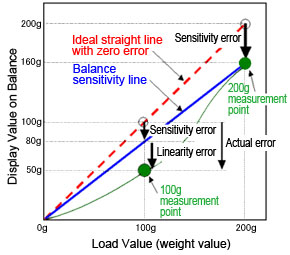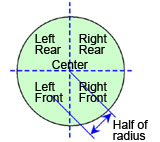Error types and corrections of electronic balance
2024-11-17 16:24:55Types of Error
1. Sensitivity Error
This indicates a difference between the value measured by the balance and the correct value. Normally, this is expressed in terms of the deviation at measurement points near the balance capacity (maximum mass measurable). As an extreme example for a balance with a 200 gram capacity, if a 200 g weight is placed on the pan but the balance displays a value of 160 g, the sensitivity error at 200 g is -40 g. This indicates that the deviation is distributed proportionally as error over the entire measurement range. For example, a measurement at 100 g is half the weight of 200 g, so it would include half the error of 200 g, or -20 g.
Sensitivity error occurs based on how accurately calculations are performed when force is converted to mass, as described above in How Electronic Balances Work. The method used to convert force to mass is always described in instruction manuals and is referred to as sensitivity adjustment, calibration, or span adjustment. Placing the balance in different locations can results in variations in gravitational acceleration or variations in room temperature that can affect conversion. Sensitivity error can increase or decrease depending on how users adjust sensitivity.
2. Linearity Error
If the error included in balance measurement values was only the sensitivity error described above, then error would be proportional to the load value at any given measurement point. However, in reality that is not the case. That is because there are other types of error besides sensitivity error. One such error is linearity error, described in this section. The relationship between sensitivity error and linearity error is explained in Figure 1. (It shows an example of an especially large error for illustrative purposes.)
Assuming the measurement value for a 200 g weight on a 200 g balance is indicated as 160 g (sensitivity error of -40 g), then measurements of 100 g should include a proportional sensitivity error component of -20 g, resulting in a measurement value of 80 g. In other words, measurements should fall along a straight line connecting the measurement at 200 g and the origin (the sensitivity line of the balance). The area between this balance sensitivity line and an ideal line with zero error represents the sensitivity error component. However, in reality, measurements sometimes do not fall along the balance sensitivity line. For example, if the measurement value for 100 g was 50 g, then it includes an additional error of -30 in addition to the 80 g indicated by the balance sensitivity line. This additional error component is referred to as the linearity error.
Linearity error occurs due to the state of the balance itself or its original performance level. (This value is indicated in the instruction manual specifications included with each balance.) Therefore, this error level cannot be reduced by the user. Nevertheless, the sensitivity error component can be minimized by properly adjusting the sensitivity.

Balance Error - Sensitivity and Linearity
It is important to determine the composition of error in balance measurement values. In other words, it is important to determine what component of error is due to sensitivity error and what component is due to linearity error. To use the balance properly, rather than assuming the balance has malfunctioned just because the error is large, it is extremely important to always consider whether the error is due to sensitivity error or not.
3. Repeatability
Repeatability refers to the degree to which the same measurement value is obtained when repeatedly measuring the same thing and is an indication of precision level. It expresses the variability of measurement values in terms of standard deviation or band width.
Repeatability depends on the status of the balance itself and original performance level, but it also depends on how it is used (such as the containers used for measurements) and the environment (such as effects from air flow or static electricity).
4. Eccentric Error
This error occurs due to where the item is placed on the pan. In the case of round pans, this is expressed as the difference in measurement values obtained when an item is placed half a radius away from the center, in 45-degree directions (front left, front right, rear right, and rear left), compared to the measurement at the center. Eccentric error depends on the status of the balance itself and its original performance, but can be significantly reduced by being careful to place loads in the pan center.

Eccentric Error of Balances
Causes and Corrective Measures for Error
By understanding how error occurs and the factors that cause it, methods of minimizing error become apparent. The following describes some of the main factors that cause error, along with measures to minimize them.
1. Gravitational Acceleration
The biggest factor causing sensitivity error is gravitational acceleration.
This phenomenon is due to the difference in gravitational acceleration resulting from the difference in latitude. In other words, a sensitivity error occurs, where the balance measurement values become smaller as you move south and larger as you move north.
Gravitational acceleration is not only affected by latitude, but also by altitude as well.
The important point here is not about how much of a sensitivity error occurs for a given movement of the balance, or by a given change in floors of a building, rather the point is that sensitivity should be readjusted whenever the balance is moved, even for short distances.
2. Temperature
The second biggest factor causing sensitivity error is temperature. Temperature variations in the balance itself can cause sensitivity error.
One of the factors that causes balance temperature to change is room temperature. If your laboratory temperature stabilizes quickly to an appropriate temperature each morning, you may think there is no problem with temperature, but the balance itself does not change temperature as quickly as the room temperature.
It takes a long time for it to gradually adjust to temperature changes.
In some cases, if the balance sensitivity is adjusted after the air conditioner is switched on and the room temperature has stabilized in the morning, it may be possible to adjust the sensitivity at that time, but it will immediately start changing again. Eliminating room temperature variations is best, but as a practical matter we recommend performing the most important measurements (those that require the most precision) in the afternoon (after the balance has thoroughly adjusted to the room temperature). Also, always remember to adjust sensitivity immediately before measurements.
Other factors, besides room temperature, that change the balance temperature include direct sunlight and heat generated by electronic parts within the balance. To avoid these factors, keep the balance away from direct sunlight and, if possible, leave the balance power ON 24 hours a day.
3. Containers
Have you had the following experience? Using flasks or other such containers can cause a drifting phenomenon, where the indicated balance value gradually changes in one direction. This is due to the air contained in the container. For example, if the container has a lower temperature than the weighing chamber, the air in the container is heated by the interior of the weighing chamber, causing the air to expand and overflow from the container. Therefore, the indicated value on the balance gradually creeps lower.
Given a container volume of 100 cm3, a change in container temperature of 2 °C is equivalent to 0.82 mg. These conditions will cause measurement repeatability to increase (become worse). To avoid this situation, have the container adjust to the balance temperature as much as possible, such as by leaving the container next to the balance and not touching the container with bare hands.
4. Air Flow
It is easy to imagine how the beam of a mechanical weighing balance could fluctuate when exposed to external air flow. The same thing applies to electronic balances as well. The presence of air flow can cause worse stability and repeatability or other consequences.
1) Air Flows From External Sources
There are many factors in our immediate surroundings that can cause air flow, such as air conditioners and the movement of people, but one factor that is often overlooked is the door to the room. If the door is a swinging type, think of it as fan that not only generates it own wind, but also changes the room air pressure, which disturbs the stability of the air inside the balance as well. These effects can be significantly prevented by taking measures with respect to the facility to prevent exposing the balance to air flow and having all personnel, including those not involved in using the balance, to cooperate together in being careful. Also, if possible, use a sliding type door.
2) Air Flows Generated Within the Weighing Chamber
If the air inside the weighing chamber convects, the pan and item being measured will be exposed to air flow, which will cause instability.
Convection can be caused by factors such as the rise or fall of air due to temperature differences between items being measured and the weighing chamber or the disturbance of air from moving items being measured in and out of the weighing chamber. To minimize convection, it is necessary to keep in mind to let items being measured thoroughly adjust to the balance temperature, to avoid inserting hands into the weighing chamber, to place or remove items being measured in as short a time as possible, and to avoid opening the weighing chamber door more than necessary. In addition, to minimize temperature differences between inside and outside the weighing chamber, we recommend leaving the weighing chamber door open a few millimeters when the balance is not in use. However, no matter how careful you are, it is difficult to completely suppress convection. Therefore, to minimize its effect, do not let items being measured protrude from the pan. Success comes from paying attention to details, such as folding the edges of weighing paper.
5. Static Electricity
Static electricity, which appears when the air starts becoming dry, can electrically charge powders, plastic or glass containers to cause the balance display value to be unstable and cause repeatability to become worse. If a problem occurs only when weighing an actual sample, but not when weighing weights, then the cause is likely static electricity.
Static electricity can be discharged to the air and eliminated by humidifying the room, but using an ionizer is also effective.
Copyright © 2024 Changzhou Roga Medical Device Co.,Ltd. All Rights Reserved.
Powered by:ShuangXi

